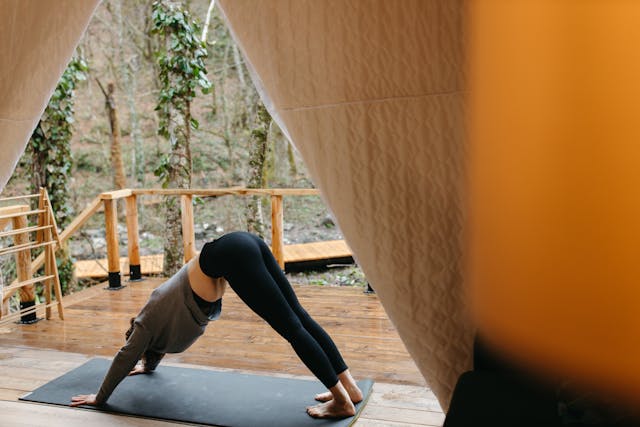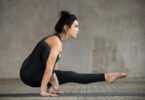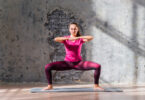Introduction to Yoga
Yoga is an ancient practice that balances the mind, body, and spirit through various poses, breathing techniques, and meditation. One of its many benefits includes deep arch stretching, which can significantly enhance flexibility and reduce back pain.
Preparing for Yoga
To get the most out of your yoga practice, it’s crucial to have a calming environment and the necessary equipment, such as a yoga mat, comfortable clothing, and possibly yoga blocks or straps.
Essential Yoga Equipment for Practicing Beautiful Poses
Before you begin your journey into beautiful yoga poses, ensure you have the right equipment. A high-quality yoga mat is essential for comfort and safety. Additionally, consider acquiring yoga blocks or straps to help with poses that require extra support or reach.
Deep Arch Stretching Techniques
Deep arch stretching primarily targets the arch of the foot, which can be particularly beneficial for individuals experiencing plantar fasciitis, flat feet, or those who want to improve their foot flexibility and strength. Here are some effective deep arch stretching techniques:
- Towel Stretch:
- Sit on the floor with your legs straight in front of you.
- Place a towel around the ball of your foot and hold both ends with your hands.
- Gently pull the towel towards you while keeping your knee straight, feeling a stretch along the bottom of your foot and heel.
- Hold this position for 15-30 seconds and repeat 2-3 times for each foot.
- Golf Ball Roll:
- While seated, place a golf ball (or a similarly sized firm ball) under the arch of your foot.
- Roll the ball back and forth from your heel to your toes, applying moderate pressure.
- Continue this movement for about 2-3 minutes on each foot.
- Arch Lifts:
- Stand with your feet flat on the ground.
- Try to lift the arch of your foot while keeping your toes and heel on the ground.
- Hold the lifted arch position for a few seconds, then release.
- Perform 10-15 repetitions for each foot.
- Stair Stretch:
- Stand on a step with your feet hanging off the edge slightly.
- Slowly lower your heels below the step until you feel a stretch in the arches and calves.
- Hold for 15-30 seconds and repeat 2-3 times.
- Toe Extension:
- Sit in a chair and place one foot on your opposite thigh.
- Use your hand to pull your toes back towards your shin.
- You should feel a stretch in the bottom of your foot and toe.
- Hold for 10-15 seconds and repeat three times on each foot.
These stretches can be performed daily and are particularly useful as a preventive measure or a way to alleviate mild discomfort. However, if you’re experiencing severe foot pain, it’s best to consult a healthcare provider before beginning any new stretch or exercise routine.
For those looking to enhance their yoga practice, consider integrating poses like the King Pigeon Pose or advanced balancing poses. These poses are beautiful and help deepen body awareness and control.
Relaxing Yoga Techniques
Relaxing yoga techniques focus on gentle poses and mindful breathing to help reduce stress, calm the mind, and promote overall relaxation. Here are several yoga techniques that are especially effective for relaxation:
- CChild’sPose (Balasana):
- Kneel on your yoga mat with your toes together and knees hip-width apart.
- Sit back on your heels, then fold forward, extending your arms in front of you.
- Rest your forehead on the mat and let your whole body release. Hold this pose for 1-3 minutes as you focus on deep breathing.
- Legs-Up-The-Wall Pose (Viparita Karani):
- Sit with one side of your body against a wall.
- Swing your legs up onto the wall as you lie back on the floor, keeping your buttocks close to the wall.
- Allow your arms to rest by your sides, palms facing up. Stay in this pose for 5-10 minutes, breathing deeply.
- Cat-Cow Stretch (Marjaryasana and Bitilasana):
- Begin on your hands and knees, wrists under shoulders, and knees under hips.
- As you inhale, arch your back and look up toward the ceiling (Cow Pose).
- As you exhale, round your spine and tuck your chin to your chest (Cat Pose).
- Continue this movement for 1-2 minutes, synchronizing the motion with your breath.
- Corpse Pose (Savasana):
- Lie flat on your back, legs slightly apart, arms relaxed at your sides, palms facing up.
- Close your eyes and focus on relaxing every part of your body.
- Remain in this pose for 5-10 minutes, practicing deep breathing and allowing your body to sink into the ground.
- Seated Forward Bend (Paschimottanasana):
- Sit on the floor with your legs straight in front of you.
- Inhale and lift your arms above your head.
- Exhale and fold forward from the hips, reaching towards your feet.
- Hold your feet or place your hands on the floor beside your legs. Stay in this position for 1-3 minutes, breathing deeply.
- Supine Spinal Twist (Supta Matsyendrasana):
- Lie on your back and bring your knees to your chest.
- Extend your arms out to the sides, forming a T shape.
- Slowly lower your knees to one side while turning your head to the opposite side.
- Hold for 1-2 minutes on each side, breathing deeply.
These techniques are designed to be soothing and are suitable for all levels of yoga practitioners. They can be performed individually or as part of a longer relaxation-focused yoga session. Remember to focus on slow, deep breathing throughout each pose to enhance the effects of relaxation.
Combining Stretching with Relaxation
Combining stretching with relaxation techniques is a beautiful way to enhance physical and mental well-being. This approach can help release muscle tension, improve flexibility, and reduce stress. Here is a guide to integrating stretching with relaxation techniques effectively:
1. Set a Calm Environment
- Ambiance: Choose a quiet space with minimal distractions. You may want to dim the lights, light candles, or play soft background music.
- Equipment: Have a yoga mat, comfortable clothing, and perhaps a few pillows or a blanket for support and warmth.
2. Begin with Breathing Exercises
- Deep Breathing: Start by sitting or lying in a comfortable position. Focus on deep, slow breaths to calm the mind and prepare the body for stretching.
- Guided Visualization: Close your eyes and imagine a peaceful place or scenario, enhancing the relaxation experience.
3. Gentle Dynamic Stretches
- Arm Sweeps: Stand or sit with your arms at your sides. As you inhale, sweep your arms up overhead. As you exhale, release them back down. Repeat several times.
- Neck Rolls: Drop your chin to your chest and gently roll your head in a circle, one direction and then the other, synchronizing your movement with your breath.
4. Static Stretches with Mindfulness
- Seated Forward Bend: Sit with your legs extended, inhale deeply, and as you exhale, bend forward gently from the hips. Hold and breathe deeply, paying attention to the sensations in your body.
- Butterfly Pose: Sit with the soles of your feet together, knees bent out to the sides. Hold your feet with your hands and gently lean forward, breathing deeply and allowing your muscles to relax more with each exhale.
5. Incorporate Relaxation Poses
- CChild’sPose: This pose is excellent for relaxation. Kneel, sit back on your heels, then fold forward with your forehead on the mat and arms extended. Breathe deeply and allow every exhale to deepen the relaxation.
- Legs-Up-The-Wall Pose: Lie on your back and extend your legs against a wall. Allow your arms to rest by your sides, palms up, and breathe deeply, feeling the relaxation spread through your body.
6. Conclude with a Relaxation Technique
- Progressive Muscle Relaxation: Lie back comfortably. Tense and relax each muscle group sequentially from your toes to your head, holding the tension for a few seconds before releasing.
- Final Savasana: Lie flat on your back, arms by your sides, palms up, and legs slightly apart. Close your eyes and focus on relaxing every body part for 5-10 minutes.
Additional Tips
- Timing: Spend 5-10 minutes on each section, allowing your body to engage and relax fully.
- Consistency: Regular practice enhances benefits, helping to reduce stress and improve flexibility over time.
- Mindful Attention: Focus on the sensations within your body and the rhythm of your breathing to enhance the relaxation and effectiveness of each stretch.
Combining stretching with relaxation techniques improves physical flexibility and alleviates tension. It also enhances mental clarity and emotional calm. It’s an excellent routine for ending the day or preparing for stressful events.
After a session of beautiful yoga poses, it’s important to cool down and relax the body. Poses like the CChild’s Pose and the Seated Forward Bend are perfect for this, allowing the body to unwind and absorb the benefits of the practice. For detailed relaxation techniques, explore the article on Yoga for Relaxation.
Routine for Beginners
Creating a beginner-friendly routine combining stretching and relaxation techniques is a great way to introduce new practitioners to gentle exercise and mindfulness benefits. Here is a simple, efficacious routine designed for beginners:
1. Preparation and Setting
- Environment: Choose a quiet, comfortable space. Use a yoga mat or a soft rug for support.
- Ambiance: Consider soft lighting or background music to enhance relaxation.
- Time: Allocate about 20-30 minutes for this routine.
2. Warm-Up with Gentle Breathing
- Duration: 3-5 minutes.
- Technique: Sit comfortably with your back straight. Close your eyes and take deep, slow breaths. Inhale through your nose, hold for a moment and exhale slowly through your mouth.
3. Basic Stretching Exercises
- Neck Stretches:
- Gently tilt your head towards each shoulder, holding for 5 seconds on each side. Repeat three times.
- Slowly turn your head left to right, aiming to look over each shoulder. Hold for 5 seconds on each side and repeat three times.
- Shoulder Rolls:
- Roll your shoulders slowly forward for 3 rounds, then reverse and roll them backward for 3 rounds.
4. Core Stretching Movements
- Cat-Cow Stretch (Chakravakasana):
- Start on all fours. Inhale as you arch your back downward (Cow), lifting your head and tailbone. Exhale as you round your back up (Cat), tucking your chin to your chest. Continue for 1-2 minutes.
- Seated Forward Bend (Paschimottanasana):
- Sit with your legs extended forward. Inhale and raise your arms above your head. Exhale and gently fold forward from your hips, reaching toward your toes. Hold for 30 seconds, then slowly rise.
5. Relaxation Techniques
- Legs-Up-The-Wall Pose (Viparita Karani):
- Lie on your back and lift your legs against a wall. Keep your arms relaxed by your sides. Stay in this position for 5-10 minutes, focusing on deep breathing.
- Guided Relaxation:
- Remain lying on your back. Close your eyes and mentally scan your body from head to toe, releasing tension from each body part. Imagine each breath bringing calmness and each exhale taking away stress.
6. Closing and Mindfulness
- Mindful Breathing:
- Sit up slowly and cross your legs. Close your eyes and place your hands on your knees. Focus on your breath, feeling the rise and fall of your abdomen for 2-3 minutes.
- Gratitude Moment:
- Still seated, think of three things you are grateful for today. This helps cultivate a positive mindset.
Additional Tips for Beginners
- Pace Yourself: Move at a comfortable pace and do not force any stretch beyond what feels good.
- Listen to Your Body: Adjust your posture or skip the stretch if any exercise feels painful or uncomfortable.
- Consistency is Key: Regular practice will improve flexibility, relaxation, and overall well-being.
This routine is designed to be accessible and enjoyable for beginners, providing a solid foundation for physical and mental relaxation. As you become more comfortable with these exercises, you can gradually increase the duration or complexity of the stretches and relaxation techniques.
FAQs
Is Deep Stretch Yoga Good for You?
Deep stretch yoga, often referred to as Yin yoga, focuses on holding poses for longer periods to target deep connective tissues in the body such as ligaments and fascia. It is particularly beneficial for improving flexibility, releasing tension, and promoting relaxation. By holding poses for a few minutes, this type of yoga also helps develop patience and mental calmness. Additionally, deep-stretch yoga can improve joint mobility and circulation. However, it’s important for individuals to practice under guidance, especially if they have any existing injuries or health conditions.
Can an Inflexible Person Do Yoga?
Absolutely! Yoga is for everyone, regardless of their flexibility level. Many people begin yoga feeling inflexible, and through consistent practice, they notice improvements in their flexibility and overall physical health. Yoga poses can be modified and adapted to accommodate all body types and flexibility levels. Instructors often use props like blocks, straps, and cushions to help beginners achieve proper alignment and gradually increase their flexibility.
How Do You Stretch a Sore Back?
Stretching a sore back should be done gently and cautiously to avoid exacerbating pain. Here are a few gentle stretches you can try:
Child’s Pose: This classic yoga pose helps relax the spine, hips, and thighs, while gently stretching the lower back.
Cat-Cow Stretch: This movement-based stretch helps increase flexibility in the spine and relieves tension in the torso and neck.
Knee-to-Chest Stretch: Lying on your back, pull your knees to your chest and hold to help relieve tension in your lower back.
Pelvic Tilt: This simple exercise strengthens abdominal muscles and stretches the lower back.
What is a Yoga Stretch Class?
A yoga stretch class typically focuses on improving flexibility and relieving muscle tightness using various yoga poses. Unlike more vigorous styles of yoga, a yoga stretch class usually moves at a slower pace, emphasizing longer holds in poses that facilitate deep stretching. This type of class is excellent for beginners, those recovering from injuries, or anyone looking to enhance their flexibility. Props are often used to help maintain balance and deepen the stretch without strain. Classes may incorporate Yin yoga, restorative yoga, or gentle flow sequences to achieve these goals.
Conclusion
Deep arch stretching and relaxing yoga offers numerous health benefits, including improved flexibility, better posture, and stress reduction. Regular practice is encouraged to fully experience yoga’s transformative effects.







